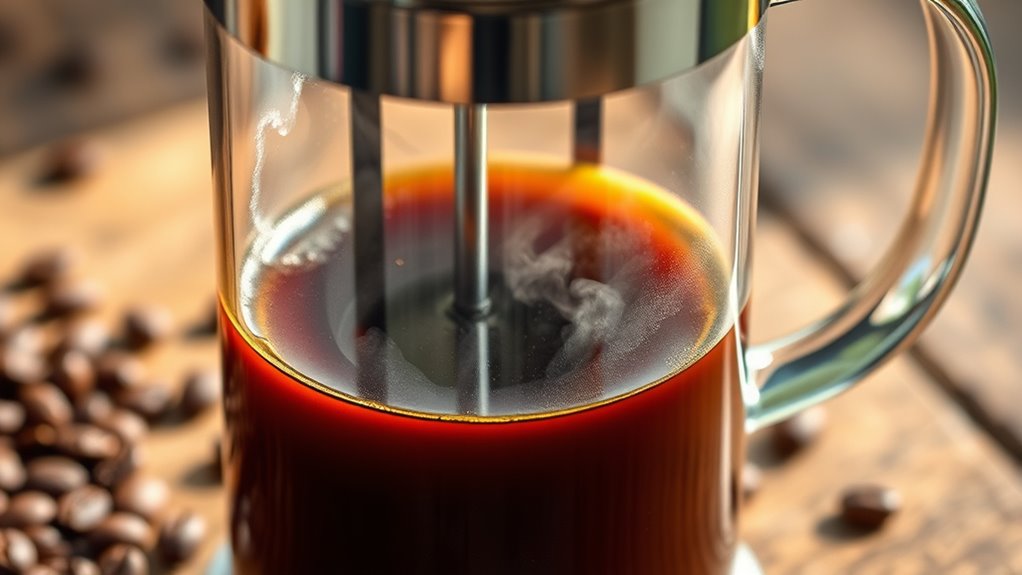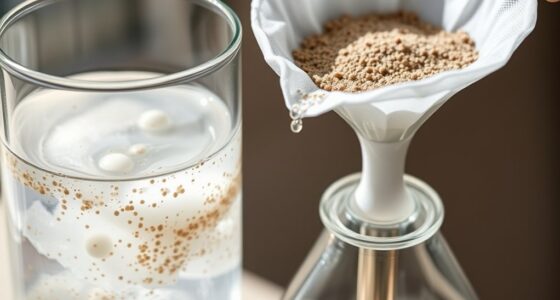Using a French press is perfect for highlighting the bright acidity and delicate aromas of light roasts. You should use coarsely ground beans, steep for about four minutes, and press gently to prevent over-extraction. Choosing fresh, single-origin, light or blonde roasts enhances their nuanced flavors. Proper timing, proper grind size, and careful handling help preserve the lively character of your brew. Keep exploring to discover more tips for maximizing your light roast experience.
Key Takeaways
- Use coarsely ground beans to prevent over-extraction and preserve delicate flavors.
- Steep the coffee for about four minutes to maximize aroma and acidity retention.
- Select fresh, single-origin, light roast beans for vibrant, nuanced flavor profiles.
- Handle the plunger gently during pressing to avoid over-extracting and dulling brightness.
- Store beans properly to maintain aromatic freshness, ensuring lively and crisp light roast cups.

Have you ever wondered why a French press is an excellent choice for brewing light roasts? It all comes down to the brewing techniques and coffee bean selection that maximize the unique qualities of light roasts. Light roasts are prized for their vibrant acidity, complex aroma, and nuanced flavors, all of which can be preserved and highlighted with the right method. The French press offers a straightforward, full-immersion brewing process that allows the coffee to steep evenly, extracting delicate oils and aromatic compounds without harsh extraction or over-extraction. This method guarantees that the subtle brightness of light roasts remains intact, giving you a fresh and lively cup every time.
French press preserves the vibrant acidity and delicate aromas of light roasts through full-immersion brewing.
When it comes to brewing techniques, precision and timing are key. You want to start with coarsely ground coffee—about the texture of breadcrumbs—so that the water can extract flavors thoroughly without becoming bitter. Steeping the coffee for about four minutes is usually ideal, but you can adjust slightly based on your taste preferences. Once the brewing time is up, slowly and carefully press the plunger down to separate the grounds from the liquid. This gentle process prevents over-extraction, which can dull the bright notes characteristic of light roasts. Remember, the goal is to maintain clarity and vibrancy, so avoid rushing or pressing too hard.
Coffee bean selection plays an equally essential role in brewing light roasts with a French press. Choose beans that are specifically labeled as light or blonde roasts, as these are roasted for a shorter time, preserving more of the beans’ original flavors. Single-origin beans often work exceptionally well because they showcase the distinct terroir’s nuances—think floral, fruity, or citrusy notes. When selecting beans, prioritize freshness; coffee is best used within a month of its roast date. Fresh beans ensure that the aromatic compounds are at their peak, which is fundamental for a flavorful light roast brew. Also, consider the origin and processing method; washed or wet-processed beans tend to produce cleaner, brighter cups, aligning perfectly with the light roast profile. Additionally, proper storage helps maintain the beans’ freshness and aromatic qualities over time.
In essence, your choice of brewing techniques and coffee bean selection directly influences how well you capture the bright, aromatic qualities of light roasts in a French press. By paying attention to grind size, steeping time, and bean freshness, you can craft a cup that highlights the lively acidity and intricate aromas that make light roasts so appealing. The French press’s simple yet effective process empowers you to enjoy the full spectrum of light roast flavors, making each sip a vibrant experience.
Frequently Asked Questions
How Does Grind Size Affect Light Roast Extraction in a French Press?
You should use a coarse, consistent grind size to optimize extraction time and preserve the light roast’s acidity and aroma. If the grind is too fine, extraction becomes overextended, leading to bitterness and loss of delicate flavors. Conversely, a too-coarse grind results in under-extraction, dulling the bright notes. Maintaining grind consistency guarantees even extraction, allowing you to enjoy the vibrant acidity and nuanced aroma that light roasts offer.
Can Adding Salt or Other Additives Improve Light Roast Flavor?
Adding salt or other additives can enhance flavor by balancing acidity and bringing out aroma in light roasts. Salt addition, in particular, can suppress bitterness and highlight subtle fruity or floral notes. You should experiment carefully, starting with a small pinch, to avoid overpowering the delicate flavors. This simple step can make your light roast coffee taste more vibrant and well-rounded, elevating your overall brewing experience.
What Is the Ideal Steeping Temperature for Light Roasts?
You might think you need a precise magic number, but honestly, the ideal steeping temperature for light roasts is around 195-205°F. Keep your coffee fresh and brewing temperature just right to preserve those delicate acidity and aroma notes. Too hot, and you risk losing brightness; too cool, and flavors stay underdeveloped. So, aim for that sweet spot—your taste buds will thank you for the perfect balance.
How Long Can I Leave Light Roast Coffee in the French Press?
You can leave light roast coffee in the French press for about 3 to 4 minutes. This brew duration strikes a balance between extracting the delicate flavors and preserving the coffee’s natural acidity and aroma. If you steep it longer, you risk over-extraction, which dulls the bright notes. For ideal flavor preservation, stick to this time, and consider a quick swirl before pressing to enhance the overall taste.
Does Water Mineral Content Influence Acidity in Light Roast Brewing?
Like a painter choosing vibrant colors, your water mineralization influences your coffee’s acidity. Higher mineral content can elevate the pH balance, making your brew brighter and more lively, while softer water preserves delicate acidity in light roasts. So, yes, water mineral content directly impacts acidity, shaping the aroma and flavor. For the best light roast experience, aim for water with balanced mineralization to highlight those nuanced, lively notes.
Conclusion
So, when you use a French press for light roasts, you preserve acidity, enhance aroma, and enjoy clarity in every sip. You unleash brightness, you reveal complexity, and you savor freshness with each brew. The French press keeps your coffee vibrant, your flavors lively, and your experience authentic. Embrace the method that highlights your coffee’s best qualities—because when you brew thoughtfully, you taste the difference every time.









